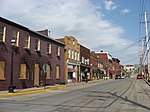Rochester–Monaca Bridge
1896 establishments in PennsylvaniaBridges completed in 1896Bridges completed in 1930Bridges completed in 1986Bridges in Beaver County, Pennsylvania ... and 5 more
Bridges over the Ohio RiverContinuous truss bridges in the United StatesRoad bridges in PennsylvaniaSteel bridges in the United StatesSuspension bridges in Pennsylvania

The Rochester–Monaca Bridge/Monaca–Rochester Bridge is a steel through continuous truss bridge which crosses the Ohio River between Monaca, Pennsylvania and Rochester, Pennsylvania. It opened in 1986 and is the third bridge to occupy the site. It replaced a 1930 steel truss cantilever bridge which itself replaced a suspension bridge built in 1896.
Excerpt from the Wikipedia article Rochester–Monaca Bridge (License: CC BY-SA 3.0, Authors, Images).Rochester–Monaca Bridge
Monaca-Rochester Bridge,
Geographical coordinates (GPS) Address External links Nearby Places Show on map
Geographical coordinates (GPS)
| Latitude | Longitude |
|---|---|
| N 40.6965 ° | E -80.2825 ° |
Address
Rochester-Monaca Bridge/Monaca-Rochester Bridge
Monaca-Rochester Bridge
15074
Pennsylvania, United States
Open on Google Maps










